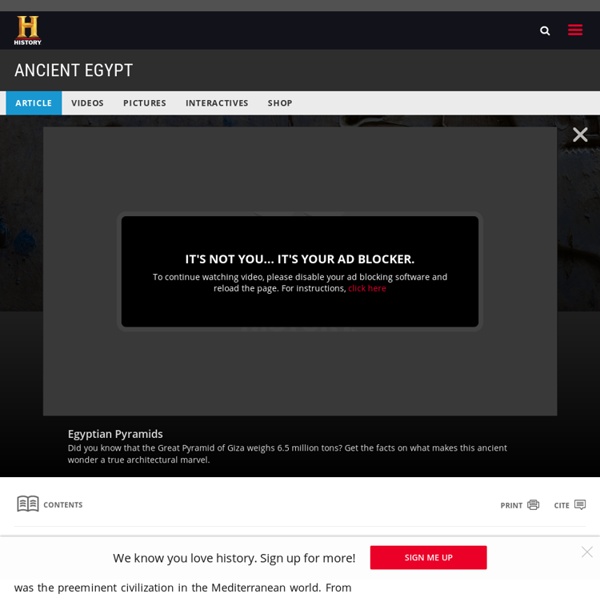Carnegie Museum of Natural History: Life in Ancient Egypt
Life in Ancient Egypt Welcome to Life in Ancient Egypt, a companion online exhibition to Walton Hall of Ancient Egypt at Carnegie Museum of Natural History. Carnegie Museum of Natural History has acquired Egyptian artifacts since its founding and now holds about twenty-five-hundred ancient Egyptian artifacts. The most significant of these objects, over six hundred of them, are displayed in Walton Hall of Ancient Egypt.
Hunahpu and Xbalanque - The Maya Hero Twins
The Hero Twins are famous Mayan semi-gods called Hunahpu and Xbalanque, whose story is narrated in the Popol Vuh (“The Book of Council”). The Popol Vuh is the sacred text of the Quiché Maya of the Guatemalan highlands, and it was written during the Early Colonial period, probably between 1554–1556, although the stories within it are clearly much older. The First Hero Twins Hunahpu and Xbalanque are the second Hero Twins in Maya mythology.
Ancient Egyptian mummies unearthed after more than 2,600 years
SAQQARA, Egypt — More than 2,600 years since they were buried, archaeologists in Egypt said Saturday they had found at least 59 ancient coffins in a vast necropolis south of the country's capital Cairo, one containing the pristine mummy of an ancient priest. The ornate sarcophagi have remained unopened since they were entombed near the famed Step Pyramid of Djoser in Saqqara, according to Egypt's Ministry of Tourism and Antiquities. Footage shared by the ministry showed colorful sarcophagi decorated with ancient Egyptian hieroglyphics. Other artifacts and at least 28 statues were found in the two deep wells, the ministry said. A sealed door was also unearthed where it is expected more mummies may lie behind, said Khaled el-Anany the first Minister of Antiquities and Tourism, adding that the artifacts were in an excellent state of preservation and would be displayed in the Grand Egyptian museum next year.
Explore Ancient Egypt
Explore Ancient Egypt With 360-degree and other imagery, walk around the Sphinx, enter the Great Pyramid, visit tombs and temples, and more. Want to walk around the Sphinx? Clamber inside the Great Pyramid of Giza and seek out the pharaoh's burial chamber? Visit the magnificent tombs and temples of ancient Thebes? In this multi-layered, highly visual interactive, view 360° panoramas, "walkaround" photos, and other breathtaking imagery shot throughout the Giza Plateau and ancient Thebes (modern-day Luxor), often with special permission.
Xibalba - Maya Place of Fear
Xibalba Underworld Discovered by Maya Archaeologists Xibalba Maya Place of Fear Xibalba Underworld Discovered by Maya Archaeologists Xibalba Would you go swimming in a hidden, sacred sinkhole or “cenote” that the Maya believed led to their gruesome underworld of Xibalba? Tourists may today brave the clear, refreshing pools, but do the locals dare trespass in the domain of their ancestors’ underworld gods? What is Xibalba? Xibalba (pronounced: Shee-bal-ba) is the name the K’iche Maya gave to their underworld and means “place of fear or fright“.
10 facts about Ancient Egypt!
Country fact file: Egypt todayIncredible ancient monuments, scorching deserts and bustling cities – this ancient country is now a sprawling, modern landscape! Read on to learn about the Egypt of today… Egyptian flag OFFICIAL NAME: Arab Republic of EgyptFORM OF GOVERNMENT: RepublicCAPITAL: CairoPOPULATION: 87, 562, 261OFFICIAL LANGUAGE: ArabicMONEY: Egyptian pound, guinayAREA: 1,001,449 square kilometresMAJOR MOUNTAIN RANGES: Eastern HighlandsMAJOR RIVER: NileFLAG: Map of Egypt Egypt: geography and landscape Without the Nile River, all of Egypt would be desert. Only about an 2.5cm of rain falls throughout Egypt each year.
King Tut Revealed
By A.R. Williams He was just a teenager when he died. The last heir of a powerful family that had ruled Egypt and its empire for centuries, he was laid to rest laden with gold and eventually forgotten. Since the discovery of his tomb in 1922, the modern world has speculated about what happened to him, with murder the most extreme possibility.
Xibalba
Xibalba (Shee-bal-ba) was the name the K'iche Maya gave to the underworld. For the Yucatec Maya the underworld was known as Metnal. The name Xibalba translates as 'Place of Fright', which indicates the terror the place had in the Maya imagination.



